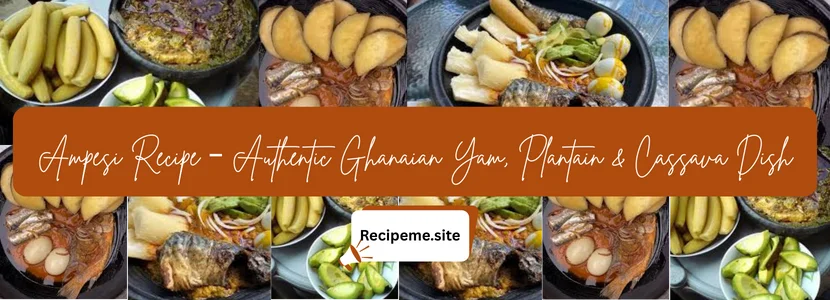
Introduction
Have you ever craved a meal that is both simple and deeply satisfying? In Ghana, that meal is often Ampesi—a hearty dish of boiled yam, plantain, or cassava served with rich, flavorful stews.
Ampesi is one of those meals that reminds people of home, childhood, and family gatherings. Whether enjoyed in a rural village or at a modern Accra restaurant, Ampesi has a way of making you feel grounded.
I still remember my grandmother serving hot slices of yam with kontomire (cocoyam leaves) stew, topped with smoked fish. The aroma alone could gather the entire household. That’s the beauty of Ampesi—it’s not just food, it’s an experience.
History of Ampesi
Ampesi has been a staple in Ghana for generations, especially among the Akan people. The word “Ampesi” originates from the Akan language, meaning boiled root or tuber. It reflects the traditional Ghanaian reliance on starchy foods like yam, cocoyam, cassava, and plantain as dietary foundations.
Historically, Ampesi was favored for its nutritional value and energy-boosting properties, making it a reliable meal for farmers and laborers. Today, it remains a go-to dish for both everyday dining and special occasions.
Did you know? Yams were introduced to West Africa over 5,000 years ago and are still celebrated annually during yam festivals in Ghana and Nigeria.
Essential Ingredients
The beauty of Ampesi lies in its simplicity. The basic ingredients include:
-
Yam, plantain, or cassava (sometimes cocoyam or sweet potatoes)
-
Salt (optional, for boiling)
-
Stew – most commonly kontomire (cocoyam leaves), garden egg stew, or tomato stew.
Common Stew Ingredients
-
Palm oil or vegetable oil
-
Tomatoes, onions, and peppers
-
Smoked fish, mackerel, or meat
-
Seasonings (salt, bouillon, local spices)
Variations of Ampesi
Ampesi isn’t a one-size-fits-all dish. Different regions and households prepare it in unique ways:
-
Yam Ampesi – the most traditional and widely enjoyed.
-
Plantain Ampesi – can be ripe (sweet) or unripe (savory).
-
Cassava Ampesi – often combined with plantain for variety.
-
Mixed Ampesi – a combination of yam, plantain, and cassava.
-
Festival Ampesi – served with assorted meats, eggs, and richly spiced stews during festive periods.
Preparation (Step-by-Step Guide)
Step 1: Prepare Tubers
Peel yam, plantain, or cassava. Cut into medium chunks and wash thoroughly.
Step 2: Boil
Place in a pot of water, add a pinch of salt, and boil until tender (about 20–30 minutes depending on the tuber).
Step 3: Prepare the Stew
In a saucepan, heat palm oil or vegetable oil. Add onions, tomatoes, peppers, and seasonings. Stir in smoked fish or meat and allow the flavors to simmer.
Step 4: Serve
Drain the boiled yam, cassava, or plantain. Plate and serve with the hot stew.
Cultural Significance
Ampesi is more than just food—it is a symbol of nourishment, family, and tradition.
In Akan culture, Ampesi is often served to visitors as a sign of hospitality. It is also a common meal after church on Sundays, bringing families together around a shared dish.
Because it uses locally grown tubers and vegetables, Ampesi is a proud reflection of Ghana’s agricultural wealth.
Serving Suggestions
Ampesi can be enjoyed in many creative ways:
-
With kontomire stew (cocoyam leaves, palm oil, smoked fish).
-
With tomato or garden egg stew (flavored with onions and pepper).
-
With groundnut (peanut) stew for a richer taste.
-
Served alongside avocado slices for a modern twist.
-
Complemented with fried fish, boiled eggs, or grilled chicken.
Types of Ampesi
-
Everyday Ampesi – simple, boiled yam or plantain with tomato stew.
-
Special Ampesi – includes mixed tubers and richer stews.
-
Health-conscious Ampesi – often made with unripe plantains due to their lower sugar content, paired with vegetable-based stews.
Tips for Making the Perfect Ampesi
-
Choose firm, mature yam or plantain for the best texture.
-
Add a pinch of salt to boiling water to enhance flavor.
-
Pair unripe plantains with spicy stews for balance.
-
For cassava, ensure the woody core is removed before boiling.
Did you know? Unripe plantain in Ampesi is packed with resistant starch, which helps regulate blood sugar levels.
Other Valuable Information
-
Ampesi is naturally gluten-free and suitable for celiac diets.
-
It is rich in fiber, potassium, and vitamins, depending on the tuber used.
-
It’s one of the most versatile Ghanaian dishes, easily adapted for vegan or vegetarian diets.
-
Unlike heavy fufu or banku, Ampesi is lighter yet filling, making it a balanced option for dinner.
Personal Experience / Journey of Discovery
On one of my trips to Kumasi, I had Ampesi with kontomire stew at a small roadside eatery. The cook served it with smoked salmon and boiled eggs. That single meal taught me why Ghanaians hold this dish close—it’s wholesome, healthy, and deeply comforting.
Now, whenever I crave something hearty yet simple, Ampesi is my go-to. It reminds me of community, love, and the joy of sharing food with others.
A Reflective Closing
Ampesi, whether made with yam, plantain, or cassava, is more than a dish—it is a heritage meal that celebrates Ghana’s culinary richness. Its simplicity is its strength, offering nourishment, comfort, and cultural pride.
So, the next time you’re looking for a wholesome, authentic West African dish, give Ampesi a try. You might just discover a new favorite.
Frequently Asked Questions
1. What is Ampesi made of?
Ampesi is made from boiled yam, plantain, cassava, or cocoyam, usually served with a flavorful stew.
2. Is Ampesi healthy?
Yes! Ampesi is high in fiber, vitamins, and minerals. Unripe plantain Ampesi is especially recommended for people monitoring blood sugar.
3. Which stew goes best with Ampesi?
Popular options include kontomire stew, tomato stew, groundnut stew, and garden egg stew.
4. Can I mix different tubers for Ampesi?
Absolutely. Many people combine yam, plantain, and cassava for variety in taste and texture.
5. How is Ampesi different from fufu or banku?
While fufu and banku are pounded or fermented dishes, Ampesi is simply boiled, making it lighter and quicker to prepare.
6. Is Ampesi eaten outside Ghana?
Yes. Variations exist in Nigeria, Togo, and other West African countries, though Ghanaian Ampesi has its unique identity.
